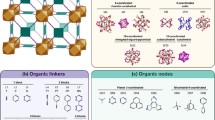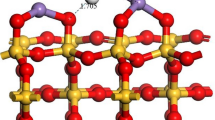Abstract
The study of materials in the nanoscale regime has important applications for catalytic reactions, the energy industry and medicine. We performed exploratory density functional theory calculations for molybdenum disulphide (MoS2) and calcium carbonate (CaCO3) nanoparticles (NPs), the former being developed as a hydrogenation and coke-prevention catalyst and the latter representing the catalytic support in some reservoirs. Utilizing Born–Oppenheimer Molecular Dynamics with reduced masses as a global optimization method, we found Mo8S16 and Mo16S32 NPs with lower-lying energies than those of locally optimized crystal geometries. Our results suggest that MoS2 NPs prefer a tetragonal lattice arrangement which is in agreement with previous studies of smaller MoS2 NPs. It remains to be seen how prenucleation MoS2 clusters of the hexagonal phase are formed. The CaCO3 NPs showed small energy differences between vastly different conformations. Therefore, in order to capture only their supporting effects in reservoirs, one should consider keeping a substantial part of the models fixed.





Similar content being viewed by others
References
Krishnan U, Kaur M, Singh K et al (2019) A synoptic review of MoS 2: synthesis to applications. Superlattices Microstruct 128:274–297
Eda G, Fujita T, Yamaguchi H et al (2012) Coherent atomic and electronic heterostructures of single-layer MoS 2. ACS Nano 6:7311–7317. https://doi.org/10.1021/nn302422x
Vazirisereshk MR, Martini A, Strubbe DA, Baykara MZ (2019) Solid lubrication with MoS2: a review. Lubricants 7:57
Khalkhali M, Zhang H, Liu Q (2018) Effects of thickness and adsorption of airborne hydrocarbons on wetting properties of MoS2: an atomistic simulation study. J Phys Chem C 122:6737–6747. https://doi.org/10.1021/acs.jpcc.8b00481
Jaramillo TF, Jørgensen KP, Bonde J et al (2007) Identification of active edge sites for electrochemical H2 evolution from MoS2 nanocatalysts. Science 80(317):100–102. https://doi.org/10.1126/science.1141483
Kim BH, Heo J, Kim S et al (2020) Critical differences in 3D atomic structure of individual ligand-protected nanocrystals in solution. Science 80(368):60 LP-67 LP. https://doi.org/10.1126/science.aax3233
Mom RV, Louwen JN, Frenken JWM, Groot IMN (2019) In situ observations of an active MoS2 model hydrodesulfurization catalyst. Nat Commun 10:2546. https://doi.org/10.1038/s41467-019-10526-0
Helveg S, Lauritsen JV, Lægsgaard E et al (2000) Atomic-scale structure of single-layer MoS2 nanoclusters. Phys Rev Lett 84:951–954. https://doi.org/10.1103/PhysRevLett.84.951
Lauritsen JV, Nyberg M, Vang RT et al (2003) Chemistry of one-dimensional metallic edge states in MoS2 nanoclusters. Nanotechnology 14:385–389. https://doi.org/10.1088/0957-4484/14/3/306
Kolsbjerg EL, Peterson AA, Hammer B (2018) Neural-network-enhanced evolutionary algorithm applied to supported metal nanoparticles. Phys Rev B 97:195424. https://doi.org/10.1103/PhysRevB.97.195424
Jørgensen MS, Groves MN, Hammer B (2017) Combining evolutionary algorithms with clustering toward rational global structure optimization at the atomic scale. J Chem Theory Comput 13:1486–1493. https://doi.org/10.1021/acs.jctc.6b01119
Lee J, Lee I-H, Joung I et al (2017) Finding multiple reaction pathways via global optimization of action. Nat Commun 8:15443. https://doi.org/10.1038/ncomms15443
Kumar N, Seminario JM (2015) Computational chemistry analysis of hydrodesulfurization reactions catalyzed by molybdenum disulfide nanoparticles. J Phys Chem C 119:29157–29170. https://doi.org/10.1021/acs.jpcc.5b09712
Prodhomme PY, Raybaud P, Toulhoat H (2011) Free-energy profiles along reduction pathways of MoS2 M-edge and S-edge by dihydrogen: a first-principles study. J Catal 280:178–195. https://doi.org/10.1016/j.jcat.2011.03.017
Zhao J, Wang M, Lababidi HMS et al (2018) A review of heterogeneous nucleation of calcium carbonate and control strategies for scale formation in multi-stage flash (MSF) desalination plants. Desalination 442:75–88
Gebauer D, Völkel A, Cölfen H (2008) Stable prenucleation calcium carbonate clusters. Science 80(322):1819–1822. https://doi.org/10.1126/science.1164271
Finney AR, Rodger PM (2012) Probing the structure and stability of calcium carbonate pre-nucleation clusters. Faraday Discuss 159:47–60. https://doi.org/10.1039/c2fd20054f
Hu Y, Vasiliu M, Thanthiriwatte KS et al (2020) Thermodynamics of metal carbonates and bicarbonates and their hydrates for Mg, Ca, Fe, and Cd relevant to mineral energetics. J Phys Chem A 124:1829–1840. https://doi.org/10.1021/acs.jpca.9b11741
Murugan P, Kumar V, Kawazoe Y, Ota N (2005) Atomic structures and magnetism in small MoS2 and WS2 clusters. Phys Rev A - At Mol Opt Phys 71:063203. https://doi.org/10.1103/PhysRevA.71.063203
Wang YY, Deng JJ, Wang X et al (2018) Small stoichiometric (MoS2): N clusters with the 1T phase. Phys Chem Chem Phys 20:6365–6373. https://doi.org/10.1039/c7cp07914a
Chen M, McNeill AS, Hu Y, Dixon DA (2020) Elucidation of bottom-up growth of CaCO3 involving prenucleation clusters from structure predictions and decomposition of globally optimized (CaCO3)n nanoclusters. ACS Nano 14:4153–4165. https://doi.org/10.1021/acsnano.9b08907
Zamani A, Maini B, Pereira-Almao P (2010) Experimental study on transport of ultra-dispersed catalyst particles in porous media. Energy Fuels 24:4980–4988. https://doi.org/10.1021/ef100518r
Almao PP (2012) In situ upgrading of bitumen and heavy oils via nanocatalysis. Can J Chem Eng 90:320–329. https://doi.org/10.1002/cjce.21646
Dunlap BI, Connolly JWD, Sabin JR (1979) On first-row diatomic molecules and local density models. J Chem Phys 71:4993–4999. https://doi.org/10.1063/1.438313
Mintmire JW, Dunlap BI (1982) Fitting the Coulomb potential variationally in linear-combination-of- atomic-orbitals density-functional calculations. Phys Rev A 25:88–95. https://doi.org/10.1103/PhysRevA.25.88
Mejía-Rodríguez D, Köster AM (2014) Robust and efficient variational fitting of Fock exchange. J Chem Phys 141:124114. https://doi.org/10.1063/1.4896199
Köster AM, Reveles JU, Del Campo JM (2004) Calculation of exchange-correlation potentials with auxiliary function densities. J Chem Phys 121:3417–3424. https://doi.org/10.1063/1.1771638
Perdew JP, Burke K (1996) Generalized gradient approximation for the exchange-correlation hole of a many-electron system. Phys Rev B Condens Matter Mater Phys 54:16533–16539. https://doi.org/10.1103/PhysRevB.54.16533
Vosko SH, Wilk L, Nusair M (1980) Accurate spin-dependent electron liquid correlation energies for local spin density calculations: a critical analysis. Can J Phys 58:1200–1211. https://doi.org/10.1139/p80-159
Adamo C, Barone V (1999) Toward reliable density functional methods without adjustable parameters: the PBE0 model. J Chem Phys 110:6158–6170. https://doi.org/10.1063/1.478522
Perdew JP, Ernzerhof M, Burke K (1996) Rationale for mixing exact exchange with density functional approximations. J Chem Phys 105:9982–9985. https://doi.org/10.1063/1.472933
Chai JD, Head-Gordon M (2008) Long-range corrected hybrid density functionals with damped atom-atom dispersion corrections. Phys Chem Chem Phys 10:6615–6620. https://doi.org/10.1039/b810189b
Mardirossian N, Head-Gordon M (2014) ωB97X-V: A 10-parameter, range-separated hybrid, generalized gradient approximation density functional with nonlocal correlation{,} designed by a survival-of-the-fittest strategy. Phys Chem Chem Phys 16:9904–9924. https://doi.org/10.1039/C3CP54374A
Alvarez-Ibarra A, Köster AM (2015) A new mixed self-consistent field procedure. Mol Phys 113:3128–3140. https://doi.org/10.1080/00268976.2015.1078009
Calaminici P, Janetzko F, Köster AM et al (2007) Density functional theory optimized basis sets for gradient corrected functionals: 3d transition metal systems. J Chem Phys 126:044108. https://doi.org/10.1063/1.2431643
Godbout N, Salahub DR, Andzelm J, Wimmer E (1992) Optimization of Gaussian-type basis sets for local spin density functional calculations. Part I. Boron through neon, optimization technique and validation. Can J Chem 70:560–571. https://doi.org/10.1139/v92-079
Lovallo CC, Klobukowski M (2003) Development of new pseudopotential methods: improved model core potentials for the first-row transition metals. J Comput Chem 24:1009–1015. https://doi.org/10.1002/jcc.10251
Lovallo CC, Klobukowski M (2004) Accurate ab initio pair potentials between helium and the heavier group 2 elements. J Chem Phys 120:246–252. https://doi.org/10.1063/1.1630015
Hostaš J, Řezáč J (2017) Accurate DFT-D3 calculations in a small basis set. J Chem Theory Comput 13:3575–3585. https://doi.org/10.1021/acs.jctc.7b00365
Liedl KR (1998) Dangers of counterpoise corrected hypersurfaces. Advantages of basis set superposition improvement. J Chem Phys 108:3199–3204. https://doi.org/10.1063/1.475715
Barrientos C, Sordo JA (2007) On the application of the counterpoise correction for the basis set superposition error in geometry optimization calculations of molecular systems: Some inconsistent results. Theor Chem Acc 118:733–738. https://doi.org/10.1007/s00214-007-0345-z
Goursot A, Mineva T, Kevorkyants R, Talbi D (2007) Interaction between n-alkane chains: applicability of the empirically corrected density functional theory for van der waals complexes. J Chem Theory Comput 3:755–763. https://doi.org/10.1021/ct600373f
Grimme S, Antony J, Ehrlich S, Krieg H (2010) A consistent and accurate ab initio parametrization of density functional dispersion correction (DFT-D) for the 94 elements H-Pu. J Chem Phys 132:154104. https://doi.org/10.1063/1.3382344
Hjorth Larsen A, Jørgen Mortensen J, Blomqvist J et al (2017) The atomic simulation environment—a Python library for working with atoms. J Phys Condens Matter 29:273002. https://doi.org/10.1088/1361-648x/aa680e
Goedecker S (2004) Minima hopping: An efficient search method for the global minimum of the potential energy surface of complex molecular systems. J Chem Phys 120:9911–9917. https://doi.org/10.1063/1.1724816
Schönfeld B, Huang JJ, Moss SC (1983) Anisotropic mean-square displacements (MSD) in single-crystals of 2H- and 3R-MoS2. Acta Crystallogr Sect B 39:404–407. https://doi.org/10.1107/S0108768183002645
Graf DL (1961) Crystallographic tables for the rhombohedral carbonates. Am Mineral 46:1283–1316
Evans DJ, Holian BL (1985) The Nose–Hoover thermostat. J Chem Phys 83:4069–4074. https://doi.org/10.1063/1.449071
AM Koster, G Geudtner, A Alvarez-Ibarra, P Calaminici, ME Casida, J Carmona-Espindola, VD Dominguez, R Flores-Moreno, GU Gamboa, A Goursot, T Heine, A Ipatov, A de la Lande, F Janetzko, JM del Campo, D Mejia-Rodriguez, JU Reveles, J Vasquez-Perez, A Vela, B Zuniga-Gutierrez, DR Salahub deMon2k, Version 6. Mexico City (2018)
Cruz-Olvera D, Calaminici P (2016) Investigation of structures and energy properties of molybdenum carbide clusters: Insight from theory. Comput Theor Chem 1078:55–64. https://doi.org/10.1016/j.comptc.2015.12.019
Liang B, Andrews L (2002) Infrared spectra and density functional theory calculations of group 6 transition metal sulfides in solid argon. J Phys Chem A 106:6945–6951. https://doi.org/10.1021/jp025915+
Wang B, Wu N, Bin ZX et al (2013) Probing the smallest molecular model of MoS2 catalyst: S 2 units in the MoSn-/0 (n = 1–5) clusters. J Phys Chem A 117:5632–5641. https://doi.org/10.1021/jp309163c
Cramer SP, Liang KS, Jacobson AJ et al (1984) EXAFS studies of amorphous molybdenum and tungsten trisulfides and triselenides. Inorg Chem 23:1215–1221. https://doi.org/10.1021/ic00177a010
Jiao H, Li Y-W, Delmon B, Halet J-F (2001) The structure and possible catalytic sites of Mo3S9 as a model of amorphous molybdenum trisulfide: a computational study. J Am Chem Soc 123:7334–7339. https://doi.org/10.1021/ja0034085
Maslen EN, Streltsov VA, Streltsova NR (1993) X-ray study of the electron density in calcite, CaCo3. Acta Crystallogr Sect B Struct Sci 49:636–641. https://doi.org/10.1107/S0108768193002575
Lourenço MP, dos Santos AA, Rosa AL et al (2020) An adaptive design approach for defects distribution modeling in materials from first-principle calculations. J Mol Model 26:1–12. https://doi.org/10.1007/s00894-020-04438-w
Khorshidi A, Peterson AA (2016) Amp: A modular approach to machine learning in atomistic simulations. Comput Phys Commun 207:310–324. https://doi.org/10.1016/j.cpc.2016.05.010
Himanen L, Jäger MOJ, Morooka EV et al (2020) DScribe: Library of descriptors for machine learning in materials science. Comput Phys Commun 247:106949. https://doi.org/10.1016/j.cpc.2019.106949
Behler J, Parrinello M (2007) Generalized neural-network representation of high-dimensional potential-energy surfaces. Phys Rev Lett 98:146401. https://doi.org/10.1103/PhysRevLett.98.146401
Acknowledgements
Work supported by the National Research Council of Canada, Artificial Intelligence for Design program and by the Natural Sciences and Engineering Research Council of Canada, Discovery Grant (RGPIN-2019-03976). AMK gratefully acknowledges support from SENER-CONACyT by the project A1-S-11929.
Author information
Authors and Affiliations
Corresponding author
Ethics declarations
Conflict of interest
The authors declare no competing financial interest.
Additional information
Dedicated to Fernand Spiegelman to celebrate his seminal contributions to cluster science.
Publisher's Note
Springer Nature remains neutral with regard to jurisdictional claims in published maps and institutional affiliations.
Published as part of the special collection of articles “Festschrift in honor of Fernand Spiegelmann”.
Supplementary Information
Below is the link to the electronic supplementary material.
Rights and permissions
About this article
Cite this article
Hostaš, J., Tchagang, A., Lourenço, M.P. et al. Global optimization of ~ 1 nm MoS2 and CaCO3 nanoparticles. Theor Chem Acc 140, 44 (2021). https://doi.org/10.1007/s00214-021-02743-y
Received:
Accepted:
Published:
DOI: https://doi.org/10.1007/s00214-021-02743-y




